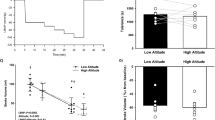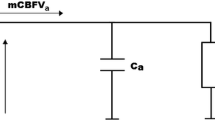Abstract
The effects of acute and repeated exposures to 500 kPa O2 on the distribution of cerebral blood flow\(\left( {\dot Q_{CBF} } \right)\) and systemic haemodynamics were assessed in awake rats. After habituation, the control rats (group 1,n=7) were restrained for 1 h daily for 8 days in air at 101 kPa, while the test rats (group 2,n=8) were exposed to 500 kPa O2 for 1 h daily for 8 consecutive days. During a final exposure, both groups were exposed to 500 kPa O2. Systolic (BPs) and mean arterial blood pressure (BP a), and heart rate (f c) were measured continuously from implanted arterial catheters; while cardiac output\(\left( {\dot Q_c } \right)\) and regional\(\dot Q_{CBF} \) were measured by the microsphere method in air before the O2 exposure, and after both 5 min and 60 min at 500 kPa O2 in all the animals. The baseline measurements in air of BPs andBP a were higher andf c was lower in group 2, while the acid-base chemistries were similar in the two groups. Total\(\dot Q_{CBF} \) was similar in both groups. However in group 2, blood flows and calculated O2 supplies to colliculi, hippocampus, hypothalamus, and most cerebral cortical regions were higher, but lower to pons and medulla oblongata. During O2 exposure\(\dot Q_c \) andf c decreased, andBP a, BPs, and peripheral vascular resistance increased in all the rats. Arterial partial pressure of CO2 and [HCO3 −] decreased in group 1, but remained at baseline levels in group 2. Total\(\dot Q_{CBF} \) and\(\dot Q_{CBF} \) decreased in both groups, and the\(\dot Q_{CBF} \) distribution was altered. Calculated O2 supplies to different brain regions varied according to the\(\dot Q_{CBF} \) changes, so that most regions sustained baseline O2 delivery, although O2 delivery to some regions may have been reduced. The decline of\(\dot Q_{CBF} \) also indicated reduced removal of waste from the brain, so that CO2 tension and temperature could have been elevated, thereby potentiating the toxic effects of O2 on brain cells. In conclusion, repeated O2 exposures induced heterogeneous and persistent changes in\(\dot Q_{CBF} \), as well as a persistent increase in arterial pressure.
Similar content being viewed by others
References
Altland PD, Brubach HF, Parker MG, Highman B (1967) Blood gases and acid-base values of unanesthetized rats exposed to hypoxia. Am J Physiol 212:142–148
Balentine JE (1982) Pathology of oxygen toxicity. Academic Press, New York
Bergø GW, Tyssebotn I (1992a) Cerebral blood flow distribution during exposure to 5 bar oxygen in awake rats. Undersea Biomed Res 19:339–354
Bergø GW, Tyssebotn I (1992b) Circulatory changes after repeated exposure to 4 bar oxygen in awake rats. In: Bakker DJ (ed) Proceedings of the 10th International Congress on Hyperbaric Medicine. Best Publishing, Flagstaff, Ariz., pp 52–59
Bergø GW, Risberg J, Tyssebotn I (1988) Effect of 5 bar oxygen on cardiac output and organ blood flow in conscious rats. Undersea Biomed Res 15:457–470
Berry S, Fitch JW, Schatte CL (1977) Influence of sex and age on the susceptibility of mice to oxygen poisoning. Aviat Space Env Med 48:37–39
Buckberg GD, Luck JC, Payne DB, Hoffmann JI, Archie JP, Fixler DE (1971) Some sources of error in measuring regional blood flow. J Appl Physiol 31:598–604
Donald KW (1947) Oxygen poisoning in man. Brit Med J 1:667–672
Hordnes C, Tyssebotn I (1985) Effect of high ambient pressure and oxygen tension on organ blood flow in conscious trained rats. Undersea Biomed Res 12:115–128
Jackson WF, Duling BR (1983) The oxygen sensitivity of hamster cheekpouch arterioles. In vitro and in situ studies. Circ Res 53:515–525
Jellestad FK, Binokay S (1992) Memory/attention changes after repeated exposure to 4 bar oxygen. In: Bakker DJ (ed) Proceedings of the 10th International Congress on Hyperbaric Medicine. Best Publishing, Flagstaff, Ariz., pp 27–32
Kerem D, Melamed Y, Moran A (1980) Alveolar CO2 during rest and exercise in divers and non-divers breathing O2 at 1 bar. Undersea Biomed Res 7:17–26
Kety SS (1951) The theory and applications of the exchange of inert gas at the lungs and tissues. Pharmacol Rev 3:1–41
Kontos HA, Wei EP (1985) Oxygen-dependent mechanisms in cerebral autoregulation. Ann Biomed Eng 13:329–334
Lambertsen CJ (1978) Effects of hyperoxia on organs and their tissue. In: Lenfant C (exec ed) Extrapulmonary manifestations of respiratory disease. Robin ED (ed) Lung biology in health and disease, vol 8. Dekker, New York, pp 239–303
Mader JT (1989) Hyperbaric oxygen committee report. Undersea and Hyperbaric Medical Society, Bethesda, Md.
Martindale V, McKay K (1992) Effect of a course of hyperbaric therapy on red blood cell deformability in dogs. Undersea Biomed Res [Suppl] 19:198
Opitz E, Bartels H (1955) Gasanalyse. In: Hoppe-Seyler F, Thierfelder HS (eds) Handbuch der Physiologischen und Pathologisch-chemischen Analyse, vol II. Springer, Berlin Heidelberg New York, pp 305–309
Risberg J, Bergø GW, Hordnes C, Tyssebotn I (1990) Distribution of cardiac output in awake rats during exposure to 5 bar. Undersea Biomed Res 17:503–514
Rudolph AM, Heyman MA (1967) The circulation of the fetus in utero. Circ Res 21:163–184
Saltzman HA, Smith WW, Fuson RL, Sieker HO, Brown IW jr (1965) Hyperbaric oxygenation. Monogr Surg Sci 2:1–68
Siesjö BK (1978) Brain energy metabolism. Wiley, Chichester, New York
Sperber GO, Bill A (1985) Blood flow and glucose consumption in the optic nerve, retina and brain; effect of high intravascular pressure. Exp Eye Res 41:639–653
Sundberg H, Zeng J-Z (1986) Effects of repeated hyperbaric hyperoxia on operant choice behavior in rats. Proceedings of the XIIth annual meeting on diving and hyperbaric medicine, European Undersea Biomedical Society, Amsterdam Holland, p 33
Thom SR (1989) Hyperbaric oxygen therapy. J Intens Care Med 4:58–74
Tiisala R (1962) Endocrine response to hyperoxia and hypoxia in the adult and newborn rat. An experimental study with radioactive phosphorus. Ann Acad Sci Fenn Serv A V Med 95:1–141
Torbati D (1987) Oxygen and brain physiological functions: a review. In: Bove AA, Bachrach AJ, Greenbaum LJ jr (eds) Underwater and hyperbaric physiology, IX. Undersea and Hyperbaric Medical Society, Bethesda, Md., pp 659–690
Wood JD (1966) Development of a strain of rats with greater than normal susceptibility to oxygen poisoning. Can J Physiol Pharmacol 44:259–265
Author information
Authors and Affiliations
Rights and permissions
About this article
Cite this article
Bergö, G.W., Tyssebotn, I. Cerebral blood flow distribution and systemic haemodynamic changes after repeated hyperbaric oxygen exposures in rats. Europ. J. Appl. Physiol. 69, 1–9 (1994). https://doi.org/10.1007/BF00867919
Accepted:
Issue Date:
DOI: https://doi.org/10.1007/BF00867919




